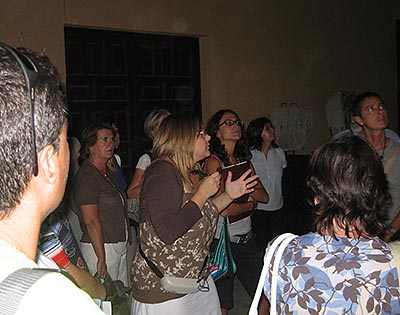BRINGING HERITAGE CLOSER. TUDELA
2 September 2008
visit guided tour of the cloister of the cathedral of Tudela
Ms. Santiaga Hidalgo Sánchez. Chair of Navarrese Heritage and Art.
During the visit various questions related to the function of the cloister, its construction, affiliations, style and iconography were explained.
The existence of the cloister of Tudela, built in the last third of the 12th century, is explained because originally Santa María was a collegiate church attended by canons under the rule of St. Augustine, which implied the construction not only of the cloister but also of several conventual dependencies, necessary for the development of the common life. The secularization of the chapter in 1238 led to the disappearance of these, although fortunately the cloister has been preserved. This then became the setting for other activities related to the collegiate church, in addition to continuing to be a setting for the liturgy and a privileged burial place.
As for stylistic affiliations, several hypotheses have been put forward. Currently, Melero Moneo has shown that the main master of the cloister of Tudela came from the workshop of Master Mateo, specifically he has been identified with the author of the capital of the temptations of Christ of the Portico de la Gloria. In addition, relations with the sculpture of San Nicolás de Tudela and the apse of the Seo de Zaragoza are noted.
The sculpture of the capitals sample an advanced style within the Romanesque, as corresponds to its chronology. Conventions and abstractions are abandoned in favor of a greater naturalism. These characteristics are especially noticeable in the capitals of the highest quality, made by the main master: the wedding at Cana and the resurrection of Lazarus.
The capitals show a very large, orderly and coherent iconographic development , with unique scenes in Hispanic Romanesque art, another of the elements that make the Tudela cloister the best example of a Romanesque cloister preserved in Navarre, also at the forefront of European art.


Two moments of the visit to the cloister of the cathedral of Tudela.
PROGRAM
TUESDAY, 2 SEPTEMBER
Place: Tudela. Dean's Palace
16.30 h: Opening and presentation of the course
16.45 h. The recovery of the ornamentation of Tudela Cathedral
Ms. Mercedes Jover Hernando. Chair of Navarrese Heritage and Art
17.45 h. Coffee break
18.15 h. Santa María de Tudela and the medieval architecture of the Ebro Valley
Mr. Javier Martinez de Aguirre Aldaz. Complutense University of Madrid
19.15 h. Artistic relations between Aragon and Navarre in the 15th century: the case of Tudela Cathedral
Ms. Carmen Lacarra Ducay. University of Zaragoza
20.15 h. visit guided tour of the cloister of Tudela Cathedral
WEDNESDAY, 3 SEPTEMBER
Place: Tudela. Dean's Palace
16.30 h. Architecture and the city in the 16th century
Ms. María Josefa Tarifa Castilla. Chair of Navarrese Heritage and Art
17.30 h. Coffee break
18.00 h. Illustrious women of the Renaissance in the Magallón palace
Ms. Mª Concepción García Gainza. Chair of Navarrese Heritage and Art
19.00 h. visit to the Magallón palace
THURSDAY, 4 SEPTEMBER
Place: Tudela. Dean's Palace
16.30 h. Art and devotions in Tudela between the 16th and 18th centuries
D. Ricardo Fernández Gracia. Chair of Navarrese Heritage and Art
17.30 h. Coffee break
18.00 h. visit guided tour of the convents of the Company of Mary, Capuchin and Dominican nuns in Tudela
FRIDAY, 5 SEPTEMBER
Place: Tudela. Dean's Palace
16.30 h. Art, report and collective identity: The commemorative monument in the city of Tudela
Mr. José Javier Azanza López. Chair of Navarrese Heritage and Art
17.30 h. Coffee break
18.00 h. Tudela and Navarrese painting from the period between the centuries
D. Ignacio J. Urricelqui. Chair of Navarrese Heritage and Art
19.00 h. The Bardenas and La Mejana. Landscape and still life in Tudela painting
D. Manuel Motilva Albericio. Director of the Muñoz Sola Museum in Tudela.
20.00 h. Closing ceremony
